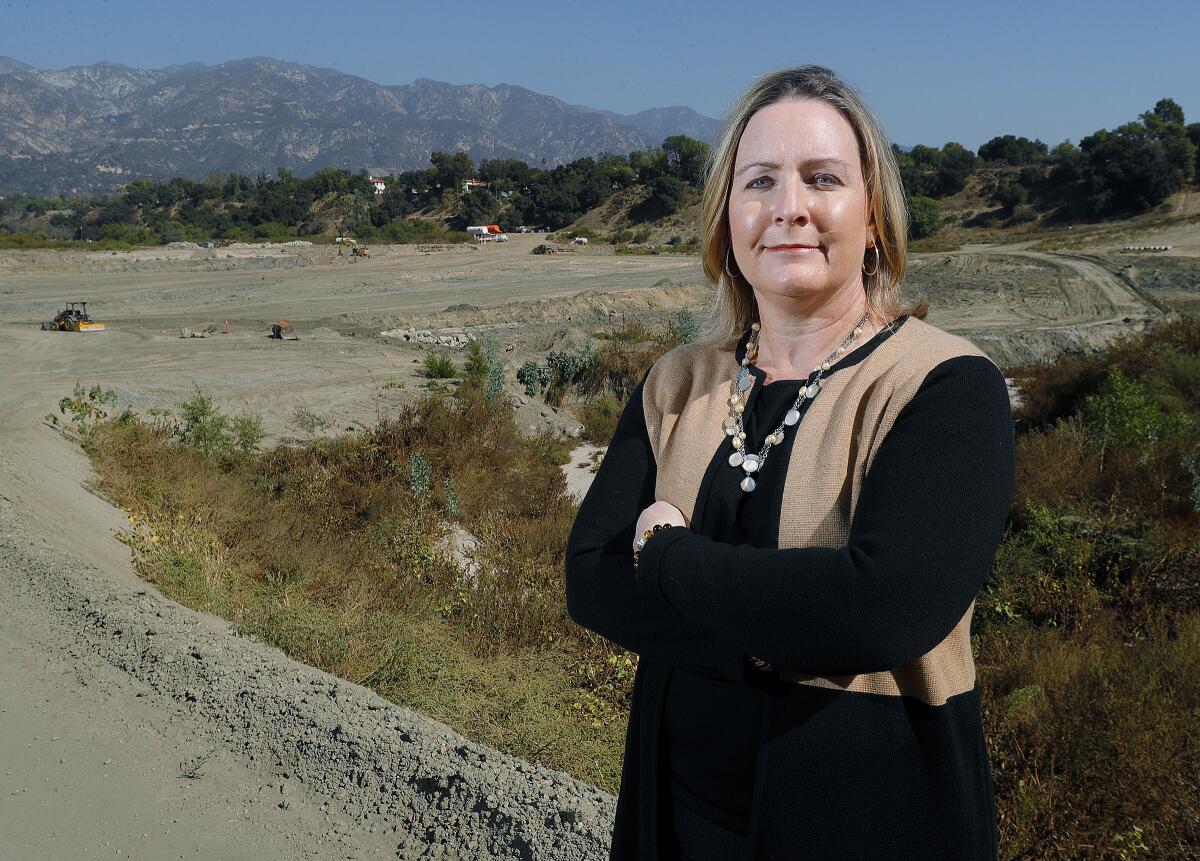Small parent effort led to big changes, county collaboration at Devil’s Gate

In September of last year, La Cañada mom and high school chemistry teacher Elizabeth Krider knew only the basic elements of the county’s plan to remove 2.8 million tons of sediment from behind Devil’s Gate Dam, where storm runoff had built for decades.
A four-year hauling project involving hundreds of daily diesel truck trips was gearing up at Hahamongna Watershed Park — a mere 1,000 yards away from where her children attended classes at La Cañada High School and from where she taught senior research classes at Flintridge Sacred Heart Academy — yet Krider admitted her knowledge was limited.
“I’d known about the dam cleanout, that it was going to happen at some time. Then it passed,” she recalled in a recent interview.
It wasn’t until she was contacted by friend and fellow La Cañada mom Esther Kornfeld, who shared with her the sheer magnitude of the project, that alarm bells went off for Krider. What impact might the allowable 425 roundtrip daily truck trips have on surrounding air quality and the health of nearby students?
Using Kornfeld’s experience as a paralegal for a firm specializing in land use and Krider’s doctorate in chemistry and knack for unpacking complex projects for her senior research students, they got to work.
She and Kornfeld pored over environmental impact reports, interviewed scientists and studied the research, sharing findings with a contingent of anxious parents who, in turn, lent their personal and professional talents.
“This is really an example of how a community can work together and make a difference,” Kornfeld said. “There is not one person who could have done this alone.”
The group’s aim was not to stop the project but to make sure crucial safeguards were established before ground was broken. They wanted more monitoring, a closer watch of diesel truck compliance and sensitivity to potential cancer risks posed by the work.
The parents addressed their concerns at an Oct. 31, 2018, meeting of the La Cañada Unified School Board meeting. LCUSD and City Council members, who’d already written letters sharing worries about the health risks the work could pose to nearby school children, were on board.
But trying to influence the momentum of a project a decade in the planning would be no small feat.
Momentum builds
By December of 2018 the parents had formed the advocacy group LCF 4 Healthy Air and were circulating a list of 12 measures the county could take to ensure potential impacts were minimized.
They shared their progress during a Dec. 5 town hall meeting at La Cañada High, where other parents were stunned to learn of the magnitude of the plans shaping up across the street.
In the audience was state Sen. Anthony Portantino (D-La Cañada Flintridge), who later met with and reviewed the group’s findings and helped broker inroads with key decision makers.
“His level of engagement was very clear to me,” Krider said of Portantino’s assistance. “He got it. That was the turning point.”
Over the next four months, public interest in implementing safeguards grew as group members were introduced to representatives from the California Air Resources Board (CARB), which monitors and enforces emissions regulations related to mobile sources, such as diesel vehicles.
“Every step we reached brought us to the next step,” Kornfeld recalled. “Our main goal was always public health and the safety of the project — knowing we were doing the right thing and for the right purpose.”
Those in high office seemed to agree.
L.A. County Supervisor Kathryn Barger insisted in April 2019 the county install air quality monitors around the dig site and hire an environmental consultant to inform the project and communicate findings to residents.
“We have an obligation to do appropriate air quality monitoring,” Barger said at the time. “It’s the right thing to do for our surrounding communities.”
After her motion passed unanimously, Barger declared, “I am convinced this project will be a model as it relates to how we’re hauling.”
Citizens grow expertise, build inroads
Hauling began in late May, and today parent advocates who weren’t very well-versed on the operational aspects of the project have become de facto experts on diesel truck emissions, particulate matter composition and fugitive dust tracking.
“We were laughing the other day at how much we know now,” Krider said. “We had no idea the depth and complexity of information we would uncover.”
LCF 4 Healthy Air members maintain ongoing communications with L.A. County Public Works directors, environmental consultants, Barger and Portantino, along with school district and city leaders.
Thanks to a collaborative effort among all parties, the county recently agreed to test emissions coming directly from the tailpipes of a cohort group of trucks in a pilot that could take place this spring. The data will be collected by UC Riverside and shared with the Air Resources Board.
Todd Sax, chief of enforcement for CARB, said his agency appreciates the efforts made by the county to address community concerns and develop the tailpipe emissions testing pilot to further monitor real-world diesel emissions.
Under the recently passed Senate Bill 210, known as the “Clean Trucks, Clean Air” act, CARB will work with state agencies to develop and standardize smog check regulations for heavy duty non-gasoline vehicles. Sax said the data collected from tailpipe testing at Devil’s Gate could help inform that process.
“The information that’s going to be collected as part of this study will be helpful to CARB in designing that program,” he said. “We’re waiting to see what the data show.”
‘A model for future civic engagement’
While local parents realize their work is not done—the project is not anticipated to be completed until 2022—they’re glad for the gains they made, as parents and citizens. In an email to the Valley Sun Tuesday, Portantino reflected on the civic process at work.
“This is an outstanding example of concerned citizens getting involved in an important local issue, doing extensive homework, expanding the circle to include parent stakeholders and then asking city, county and state officials for help and guidance,” he wrote. “This collaboration … is making a positive difference monitoring this giant public works project in what should become a model for future civic engagement and showcases our special community in action.”
Krider attributes the success of the group to members’ desires to advocate for their children.
“It’s our protective instinct as mothers that provided the stamina and force to continue to talk to people and to be professional and patient so the right thing could be done,” she said.
